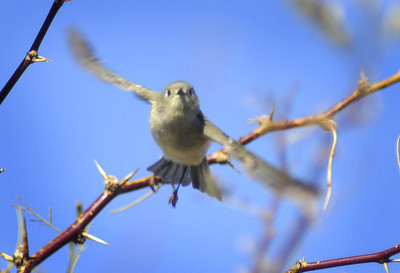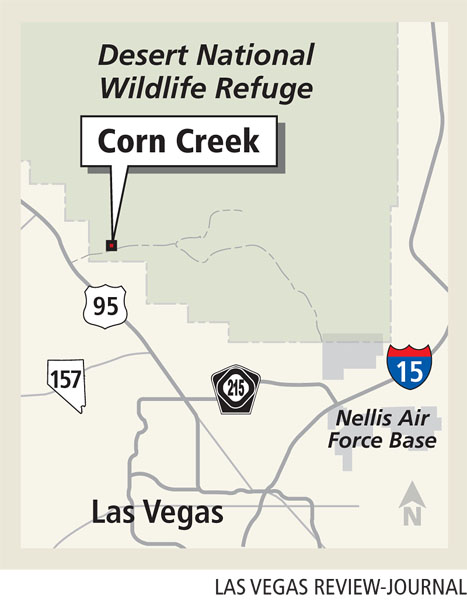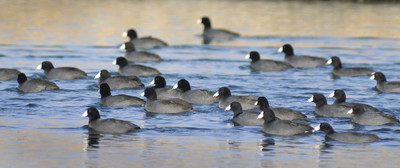Birders make list, check twice
What would a red-naped sapsucker be doing at Corn Creek on the eve of winter and just days after the biggest snowstorm to hit Las Vegas in nearly 30 years?
Trying to stay warm perhaps? Or, how about surviving on whatever bug it can peck from a piece of wood jutting from a thicket?
And were those binocular-bearing birdwatchers baffled by the buffleheads up the road?
On a more seasonal note, what was that phainopepla (pronounced "FANE-o-pep-la") feasting on in the old mesquite grove? Mistletoe berries make for an excellent entrée on the bird's menu for the annual Christmas Bird Count.
Such were the sightings Dec. 20 by a team of observers led by John Hiatt of the National Audubon Society's Red Rock Chapter.
He said red-naped sapsuckers, four in all, had descended on lower elevations in search of food. They tend to come to Corn Creek in the wintertime but move upslope in the summer to search wooded areas for insects that hide in tree bark crevices.
"They don't like hot weather either, because it stresses them out," Hiatt said.
On Dec. 20, the 42-degree temperature was bearable for sapsuckers. Three days prior, a storm had dumped 11 inches of snow on Mount Charleston and 3.6 inches on Las Vegas, the most in the valley since 7.8 inches fell during two days in 1979.
Lesser snowstorms in 1995 drove mountain bluebirds -- Nevada's state bird -- to lower elevations, sending 17 to Corn Creek and Tule Springs. This year, though, despite heavy snow, only three were counted.
"They like the open area, the pasture area, to catch insects," Hiatt said.
Christmas bird counts on the desert game range go back 70 years. The annual Audubon counts have expanded over the years to now include locations around Henderson, the Muddy River and Ash Meadows where counts are traditionally conducted in late December.
Like those locations, much has changed on the landscape around Corn Creek with golf course ponds added to the scene seven years ago on the nearby Paiute reservation. The ponds have become a convenient stopover for waterfowl in their winter migration and are within the 15-mile-diameter circle that the count includes.
That's why Hiatt said observers weren't baffled by the 11 buffleheads they saw. Eight more were recorded by another team of counters at Tule Springs.
Buffleheads, which are brilliant diving ducks, are easy to identify, Hiatt noted. "They are a spectacular duck. They really stand out with their black-and-white plumage."
As colors go, American coots are less spectacular. The chickenlike birds with dark gray feathers and white bills appear clumsy as they take off by running across water with their flapped toes.
In all, 460 were seen in the Corn Creek count, the most of any species.
"The count area included a golf course that has water and large areas of grass, which are ideal for coot. They're vegetarian and they love to eat grass. It's ideal habitat and they're thriving in man-made environments," Hiatt said.
In the mix of coots, redheads and American widgeon on golf course ponds were three hooded mergansers, a fast-flying waterfowl with hammerhead crests. The male's raised crest resembles a bufflehead's white patch except that it is outlined in black.
Three hooded mergansers, all females, were sighted at Corn Creek and 17 at Tule Springs, an indication that "hoodies," as they're called, are rebounding. For a waterfowl that nests in the cavities of trees, hooded mergansers have benefited from nest boxes bird lovers have built across the country for wood ducks. That's a sign that "hoodies and woodies" can thrive and multiply with help from conservationists.
One golden eagle was recorded during the count. The majestic bird with a 6-foot wingspan was perched atop a utility pole outside the golf course. It was probably waiting for one of its favorite meals, a jack rabbit or cottontail, to hop into striking range.
"If they find a place with a healthy population of rabbits, they'll hang around," Hiatt said.
He was puzzled, however, why other predatory birds weren't spotted this time when they've been documented in past counts.
"We didn't see any great horned owls and almost no red-tailed hawks," he said. "Raptors in general were down. Why? I don't know. It might have something to do with the weather."
There were 53 rock doves, 91 mourning doves and 16 Eurasian collared-doves but no foreign turtle doves and not a partridge in a pear tree.
A dozen Gambel's quail, however, scurried through the brush. "That would be our native equivalent to a partridge," Hiatt said.
Contact reporter Keith Rogers at krogers@reviewjournal.com or 702-383-0308.
Audio slideshow Counting Birds Observers recorded 1,420 birds representing 49 species during the Dec. 20 Christmas Bird Count conducted by the National Audubon Society's Red Rock Chapter at Corn Creek, the Desert National Wildlife Range and the nearby Pauite reservation. The bird species list and totals were compiled by Hermi Hiatt. Green Heron 1 American Wigeon 100 Redhead 47 Ring-necked Duck 11 Bufflehead 11 Hooded Merganser 3 Common Merganser 10 Ruddy Duck 73 Northern Harrier 1 Red-tailed Hawk 1 Golden Eagle 1 American Kestrel 1 Gambel's Quail 12 American Coot 460 Killdeer 1 Rock Dove 53 Mourning Dove 91 Eurasian Collared-dove 16 Greater Roadrunner 2 Red-naped Sapsucker 4 Northern (Red-shafted) Flicker 4 Say's Phoebe 2 Loggerhead Shrike 2 Western Scrub Jay 1 Common Raven 21 Horned Lark 173 Verdin 1 Cactus Wren 1 Bewick Wren 2 Marsh Wren 1 Ruby-crowned Kinglet 5 Black-tailed Gnatcatcher 1 Mountain Bluebird 3 American Robin 5 Northern Mockingbird 5 Crissal Thrasher 1 European Starling 136 American Pipit 7 Phainopepla 11 Spotted Towhee 1 Sage Sparrow 4 Savannah Sparrow 1 Song Sparrow 1 White-crowned Sparrow 21 Dark-eyed (Oregon) Junco 3 Western Meadowlark 57 House Finch 9 House Sparrow 17 Blackbird Species 25 LAS VEGAS REVIEW-JOURNAL





















